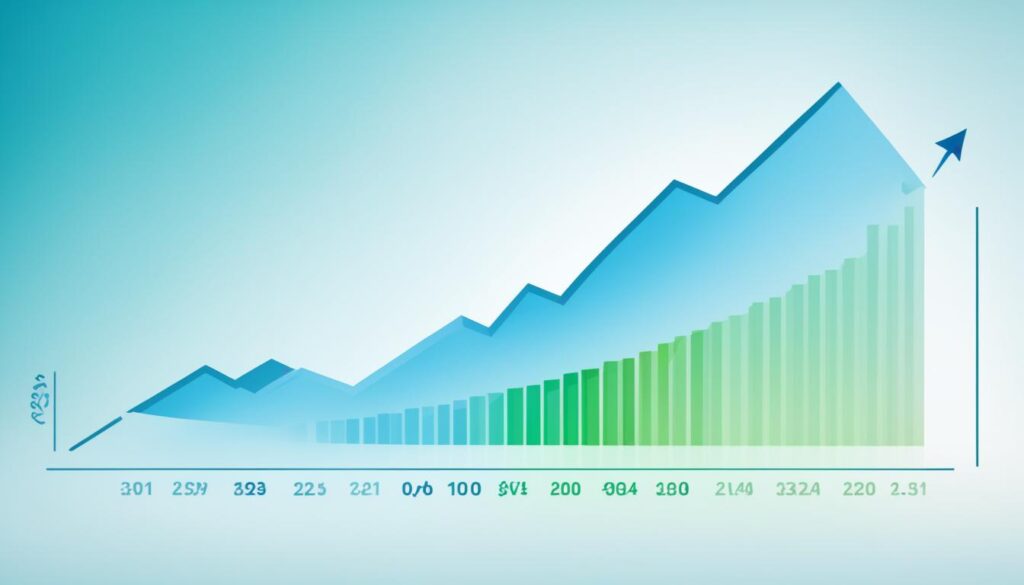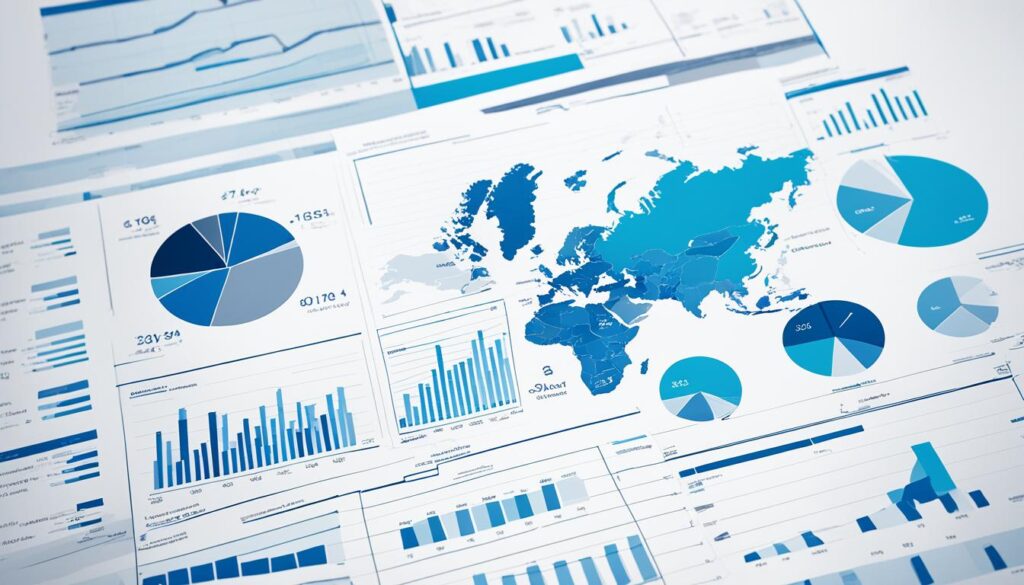Are your sales forecasts for the Philippines on point? Do you have the right strategies to guess future sales and plan for growth? In a fast-changing market, being able to predict trends and plan well is key to doing well.
It doesn’t matter if your business is big or small, knowing what affects your sales predictions is vital. With the right analysis and forecasting, you can make smart choices. This helps you set goals that really boost your earnings.

Key Takeaways:
- Accurate sales projections are crucial for businesses operating in the Philippines market.
- Understanding the sales forecasting landscape in the Philippines is essential for effective planning.
- Internal and external factors play a significant role in influencing sales projections.
- Utilizing historical data and leveraging sales projection tools can improve the accuracy of forecasts.
- Marketing strategies and the TAM SAM SOM model are important considerations in sales projections.
Understanding the Sales Forecasting Landscape in the Philippines
Sales forecasting is crucial in the lively business scene of the Philippines. It helps organizations make smart decisions. By predicting future sales, companies use their resources better, produce goods efficiently, and plan marketing well.
Defining Sales Forecast in the Philippine Context
Sales forecast estimates future sales using past data and trends. For the Philippines, this means projecting revenue and planning operations. It looks at customer behaviors, market state, and economic aspects to understand product or service demand.
Importance of Accurate Sales Projections for Filipino SMEs
Accurate sales forecasting is key for Small and Medium Enterprises (SMEs) in the Philippines. It’s vital for growth and staying profitable. It helps SMEs use resources well, manage stock effectively, and run smoothly.
It also allows for customer preference insights. This way, businesses can create focused marketing to meet customer needs.
Sales Trends and Economic Factors Influencing Projections
Many changing trends and economic factors affect sales forecasts in the Philippines. Sales trends show what Filipino consumers like and buy. These can change due to new technologies, shifting needs, and culture.
Economic elements like GDP growth and inflation also matter a lot. They influence how much people can buy and the market’s condition. Knowing these helps make accurate sales forecasts.
Internal Factors Affecting Sales Projections
When businesses forecast sales, they must look at factors inside the company. These factors can greatly change the sales outcome. Knowing and analyzing these elements helps make better forecasts.

Sales Strategy: A strong sales plan is key to predicting sales. Companies should review their sales approach often. This means finding ways to do better and making sure it matches their overall goals.
Marketing Plans: Selling plans also sway sales predictions. Reviewing marketing strategies shows ways to get customers involved more. It also helps build brand recognition and find more leads, which can boost sales.
Product Releases: Launching new items can change sales predictions a lot. Companies need to study what the market wants, who they are up against, and what people like. This guides them when predicting sales around new products.
Pricing Changes: Changing prices can directly impact sales forecasts. It’s crucial to check how price changes affect the market, competition, and profit. This insight allows firms to tweak their predictions. It helps them make wise pricing choices.
Brand Partnerships: Working with other brands can open up new ways to grow sales. Companies should pick partnerships wisely. They should also think about how these alliances might affect their sales figures. Doing so can boost their earnings.
Considering these internal factors is vital for understanding sales potential better. This knowledge helps companies develop accurate sales forecasts. It also supports making smart moves to grow and succeed.
External Elements and Their Impact on Sales Projections
Understanding how external elements affect sales projections is key for businesses. Factors like market trends, competition, economic conditions, and market changes greatly influence sales in the Philippines.
Market Trends: It’s vital for businesses to keep up with market trends. This helps them spot opportunities, predict what customers want, and tweak their sales plans. Being on top of new trends lets businesses stay ahead and meet market demands effectively.
Competition: Knowing your competition is crucial for making good sales guesses. It’s important to watch what your rivals are doing, what they’re selling, and how much they’re charging. This insight helps adapt sales forecasts to stay competitive and handle challenges better.
Economic Conditions: The economy’s health is a big deal for sales. Things like GDP growth, inflation, and consumer spending directly impact what people can buy. Accounting for these economic factors helps adjust sales plans to match what customers can and want to spend.
Market Variability: Markets can change fast because of many reasons, such as politics, natural disasters, or new tech. Recognizing and planning for these changes means businesses can make smarter sales predictions. This helps avoid losing money from guessing wrong.
To make sales forecasts that are on point, businesses must look at what’s happening outside. That means understanding market trends, what the competition is up to, the economy, and market risks.
Considering external elements helps businesses make better, more certain sales projections. Focusing on market conditions guides strategic decisions. This way, businesses can brace for challenges, find and act on chances for growth, and drive sales up.
| External Elements | Impact on Sales Projections |
|---|---|
| Market Trends | Affect customer preferences and demand, require adjustments in sales strategies |
| Competition | Influences market share, product positioning, and pricing strategies |
| Economic Conditions | Affect consumer purchasing power and overall market demand |
| Market Variability | Due to political events, natural disasters, and technological advancements |
Utilizing Historical Data to Inform Future Sales
Businesses look at past sales data to make smart guesses about the future. This helps them understand what worked before. It also guides them on what to do next to sell more. By using historical sales info, companies can make better strategies and set goals that make sense.
Analyzing Past Sales Trends for Predictive Insights
Studying old sales info offers clues for future success. Companies can see what usually happens and plan better. This way, they can change their game plan and spend resources wisely. This should up how much they sell.
If a company sees their sales always rise in a season or month, they can do more during those times. They plan ads and special offers to match what the past showed. This is like learning from the past to do better in the future.
Looking at old sales also shows what to fix. If sales slow, checking the old data can reveal why. Then, they can fix what went wrong. This keeps their sales plans sharp.
Seasonal Variations and their Role in Sales Trend Analysis
Fluctuating sales because of the season are common. This can be because of holidays or other special events. Knowing this helps in guessing how much they will sell later on.
Take retail stores, for example. They usually sell more during the holidays. By looking at what happened during past holidays, they can get ready. They stock up, hire more people, and promote more.
Changing seasons can also show where businesses can sell more. By digging into old sales numbers, companies might see new trends. This tells them what people might start wanting. With this info, they can plan ahead for more sales.

| Month | Sales Revenue ($) |
|---|---|
| January | 10,000 |
| February | 12,000 |
| March | 15,000 |
| April | 14,000 |
| May | 16,000 |
| June | 18,000 |
| July | 20,000 |
| August | 22,000 |
| September | 19,000 |
| October | 25,000 |
| November | 40,000 |
| December | 55,000 |
Methods of Sales Projection: Growth Rate vs. Acquisition-Based Forecasting
Businesses have two main ways to project sales – by growth rate or looking at acquisitions. Let’s look at these two methods. We’ll talk about what makes them good and where they fall short.
Growth rate-based forecasting looks at past sales to guess the future, assuming growth stays steady. This simple method offers a fast way to forecast sales.
Acquisition-based forecasting though, sees how much buying other companies can help sales. It looks at the bought companies’ past success to predict future results. This method factors in the benefits of merging businesses.
Both methods have their strong points and weaknesses. Growth rate forecasting is easy but doesn’t handle sudden changes well. On the flip side, acquisition forecasting is helpful but needs more detailed info and is harder to use.
Businesses should pick a method based on what suits them best. They might also use a mix of both for a better picture. For accurate predictions, you need good data, market analysis, and a solid grasp of your business environment.
In short, companies can use growth rate or acquisition data to foresee sales. Each choice comes with its own pros and cons. By smartly using available information, companies can boost their sales forecast’s precision.
Key Sales Projection Tools and Software Solutions
In this section, we’ll look at important sales projection tools and software. These help businesses predict sales better. They make forecasting easier and offer insights for smart business moves.
Choosing the Right Sales Projection Tool for Your Business
Choosing a sales projection tool means looking at your business’s needs. You want tools that fit your sales guessing needs. Look for ones that let you tweak the forecast, join data automatically, and see reports instantly.
Think about if the tool can grow with you, how easy it is to use, and if it works with your CRM. It’s key to find a tool that works smoothly with your CRM. This lets you combine sales info and make forecasting simpler.
Integrating CRM and Sales Data for Accurate Forecasting
Linking your CRM with sales tools makes forecasts more accurate. It lets you mix and study sales info from your CRM. This reveals customer habits, what and when they buy, and sales trends.
This linking helps spot connections between different data. So, you can make solid sales guesses with up-to-the-minute data. Using the CRM link well helps boost sales and makes your forecasts better.

Role of Marketing in Sales Projections
Marketing is key in shaping sales projections and boosting business growth. Good marketing can change how many products or services are expected to sell. It does this by making people aware, creating a desire, and influencing what they choose to buy. When marketing and sales goals are alike, companies make more money and reach their goals.
Marketing influences sales forecasts by finding and appealing to the right people. Market research helps marketing teams know who their ideal buyers are, what they like, and how they act. This allows businesses to create messages and strategies that really speak to their target audience. As a result, they’re more likely to sell to these customers.
Marketing also helps build the image and awareness of a brand, which is tied to sales predictions. A strong marketing plan can make a brand stand out and look good in the eyes of consumers. This makes potential buyers more inclined to choose their products or services. Building a brand increases customer loyalty and support, benefiting sales in the long run.
Marketing can improve sales forecasts by generating and following up on leads. Using strategies like content marketing and social media ads, marketing can bring in potential buyers and guide them through the buying process. This fills the sales pipeline with more interested customers, which translates to more deals closed and targets met.
“Marketing is not the art of finding clever ways to dispose of what you make. It is the art of creating genuine customer value.” – Philip Kotler
Marketing strategies also shape how customers shop or decide. By using strong messages, appealing offers, and showing social proof, campaigns can encourage buyers to act. Sales success from these tactics can be seen with metrics like conversion rates and the cost of getting a new customer.
Businesses can improve the fit between marketing and sales by watching campaign results closely. Regularly assessing data and making changes helps companies refine their marketing. This boosts marketing’s role in helping the business grow and meet its sales targets.
Marketing is critical for sales success. Taking a customer-first approach and using data to guide efforts can greatly improve a business’s sales predictions. This, in turn, helps a company make more money and grow steadily.
Setting Realistic Targets with the TAM SAM SOM Model
Setting realistic sales goals is key for any business to succeed. The TAM SAM SOM model is great for this. It lets businesses pinpoint their ideal customers and aim for reachable sales targets.
The TAM (Total Addressable Market) is the full size of the possible market for a product or service. It gives a big-picture view of the market size. This helps businesses get an idea of the market’s true potential.
The SAM (Serviceable Available Market) is part of the TAM. It’s the market a business can really reach, taking into account its abilities and the customers it targets. Knowing the SAM helps businesses concentrate on certain customers. They can then shape their sales plans to fit their needs.
The SOM (Serviceable Obtainable Market) is a smaller part of the SAM. It shows the part of the market a business can realistically compete for. It considers things like competition and market limits. Knowing the SOM guides businesses to set realistic sales goals. Then, they can create sales plans that are doable based on what they can achieve.
The TAM SAM SOM model lets businesses truly understand their market and set real sales goals. It helps avoid setting goals that are too hard to reach. Instead, businesses can focus on the right customers. They can then make plans that best use their market share to succeed.
Using the TAM SAM SOM model means businesses in the Philippines can set targets that match what they can do. It offers a clear way to plan sales. This model helps companies use their resources the best way. This way, they can make smarter choices about where to put their effort and money.
Avoiding Overconfidence in Sales Predictions
Getting sales predictions right is key for smart decisions and setting doable goals. But, being too sure of ourselves can cause problems. It leads to mistakes in sales guesses that hurt how well a business does. The trick is to dodge these errors and aim for goals that are possible.
Common Pitfalls in Forecasting Sales Targets
Businesses often fall into traps when trying to guess sales:
- Overestimating future demand: We might think sales will always get better, but that’s not true. Forgetting about the market and our competitors can mess up our guesses.
- Underestimating seasonal variations: Sales change with the seasons, and not remembering that will lead to wrong forecasts.
- Ignoring external factors: Things like the economy, market changes, or how people are spending can shake up our predictions. We need to think about these to guess right.
Maintaining a Balanced Perspective in Sales Projections
For good sales guesses, keeping things in balance during forecasting is crucial:
- Analyze historical data: Looking at past sales helps us plan for the future. It’s the basis for making realistic guesses.
- Consider a range of scenarios: Rather than betting everything on one guess, it’s good to think about different outcome options. This makes for a more complete and sensible view.
- Collaborate with cross-functional teams: Bringing together teams from all over the company stops us from being too confident. It offers more ideas and makes for safer decisions.
Keeping our sales predictions in check and being aware of risks helps set achievable goals. This leads to better forecasts and makes our sales planning and strategy stronger.
Implementing a Bottom-Up Approach in Sales Forecasts
Using a bottom-up approach in making sales forecasts can be very beneficial. This method starts by looking at individual details and then combines them. The result is a precise sales estimate. It helps businesses make better decisions by focusing on the small, important data first.
This approach lets businesses dive deep into what affects sales. They can look at things like how customers act, what’s trending in the market, and how products are doing. This detailed data gives them a better understanding of their customers and shows where they can grow.
Looking at sales from the bottom up also means checking each sales area and part closely. Businesses can then use their resources wisely and make their sales plans better. They can see what’s working and what’s not in each area. This helps them guess their sales more accurately in the end.

The bottom-up approach is good at understanding the market’s subtle parts. It helps businesses see the detailed differences in places, people, or products. By focusing on these details, the sales estimates are more likely to be on point.
Also, a bottom-up way of forecasting brings teams together. It gets the sales, marketing, and other groups to share ideas. With everyone’s knowledge, sales forecasts are more trust-worthy and correct.
To sum up, using a bottom-up approach changes how companies in the Philippines make their sales predictions. It uses detailed data and gets a lot of people’s opinions. This approach helps in making smart choices and increasing the company’s income.
Top-Down Forecasting: Aspirations Versus Achievable Sales Targets
In the sales world, setting realistic goals is a big challenge for many. Top-down forecasting helps tackle this. It starts with big sales dreams and then looks at what’s truly doable.
This method allows companies to aim high. But they also ensure their goals are firmly based in what can actually be achieved. It’s about having big dreams but being real about what is possible.
But, using top-down forecasting needs care. It’s great for inspiring teams, but being too ambitious can backfire if goals are never met. This could lower morale over time.
Setting achievable targets involves looking at the market, competitors, economy, and past data. When businesses do this well, they find that sweet spot between big dreams and what’s doable.
In setting achievable sales targets, it is essential to evaluate the market dynamics and adjust aspirations accordingly. Achieving balance in top-down forecasting ensures a healthier sales pipeline and promotes greater accuracy in sales predictions.
Let’s imagine how top-down forecasting works with a made-up example:
| Year | Aspirations | Achievable Sales Targets | Forecasting Accuracy |
|---|---|---|---|
| 2022 | $10 million | $8 million | 80% |
| 2023 | $15 million | $11 million | 73% |
| 2024 | $20 million | $16 million | 80% |
The table shows how goals become a bit smaller every year but stay in line with what’s possible. This keeps forecasts very accurate. It helps businesses make smart choices and set reachable goals.
With top-down forecasting, it’s key to keep checking and adjusting goals as you go. This keeps everything on track and offers lessons for the future.
By using top-down forecasting wisely, companies can grow steadily and achieve success over time.
Crafting a Multi-Year Sales Forecast Strategy
Benefits of Long-Term Sales Forecast Planning
Creating a multi-year sales forecast is vital for businesses wanting long-term success in the Philippines market. It brings several advantages:
- Strategic Decision-Making: It offers insights into future market conditions. This lets companies make smart choices. They can spot growth chances, manage resources well, and tweak sales plans.
- Enhanced Financial Planning: It helps create accurate financial plans and budgets. This means funds are used well and sales goals match future sales. It improves the company’s financial health.
- Risk Mitigation: Businesses are able to see and prepare for possible risks early. This lets them adapt, create backup plans, and lessen negative effects on sales and revenue.
- Investor and Stakeholder Confidence: A good sales forecast shows a company is committed to long-term growth. It makes investors and stakeholders more confident. This can attract new investors and strengthen existing partnerships.
Adjusting Your Sales Strategies Based on Long-Term Projections
After setting a multi-year sales forecast, businesses should adjust their strategies. This optimization is key to success. Here’s what to do:
- Identify Growth Areas: Use sales forecasts to find growth opportunities. Focus your resources and sales efforts there for increased revenue.
- Optimize Marketing Efforts: Tailor your marketing to the forecasts. This aims your efforts towards the right people and boosts brand recognition. Use data to make campaigns successful and keep customers.
- Revise Sales Targets: Regularly review and update your sales aims. This keeps targets realistic and your sales team motivated to achieve them.
- Monitor Market Trends: Keep an eye on market shifts and update strategies. It’s vital to follow industry news, what customers like, and your competition to remain competitive and spot new chances.
With a well-thought-out sales forecast and smart strategy tweaking, Philippine businesses can set themselves up for lasting growth and prosperity.
Conclusion
For businesses in the Philippines, getting sales projections right is key. It helps them make good choices, aim for realistic goals, and grow their income. In this article, we’ve gone over what affects sales predictions. This includes looking at past data, analyzing various factors, and choosing the best ways to forecast sales.
Businesses in the Philippines should look at both what’s happening inside and outside their company when figuring out sales estimates. They need to review their sales plans, marketing strategies, new products, and any changes in pricing. Also, spotting what’s going on in the wider market, like trends and what competitors are doing, is crucial. It helps them make better guesses about their future sales.
Examining old sales data is a powerful way to predict future figures. Businesses can find patterns and notice when sales tend to go up or down. This lets them make smarter guesses and plan better for the future.
Choosing the right tools for sales projections can make a big difference in how accurate your forecasts are. By picking the best software and combining it with your customer and sales info, businesses can forecast sales better and more efficiently. This makes it important for companies to invest in the right technology and tools.
Getting sales predictions right matters a lot in the Philippines market. By using the strategies we’ve talked about, businesses can make their forecasts more accurate. They can also set better goals. This means thinking about both what’s happening in and outside their company, looking at the past, and using the right technology. These steps can help businesses not only plan well but also grow their sales.
